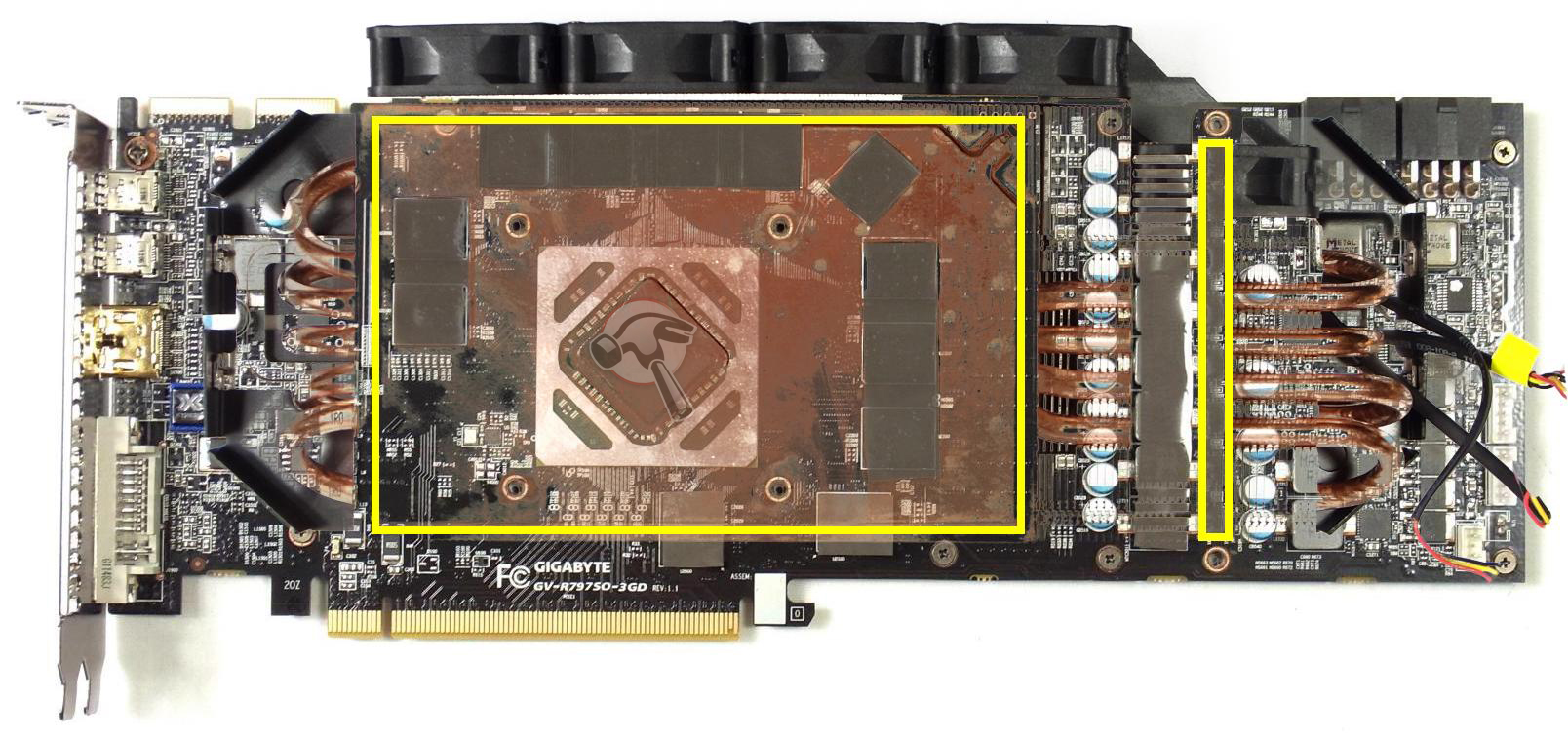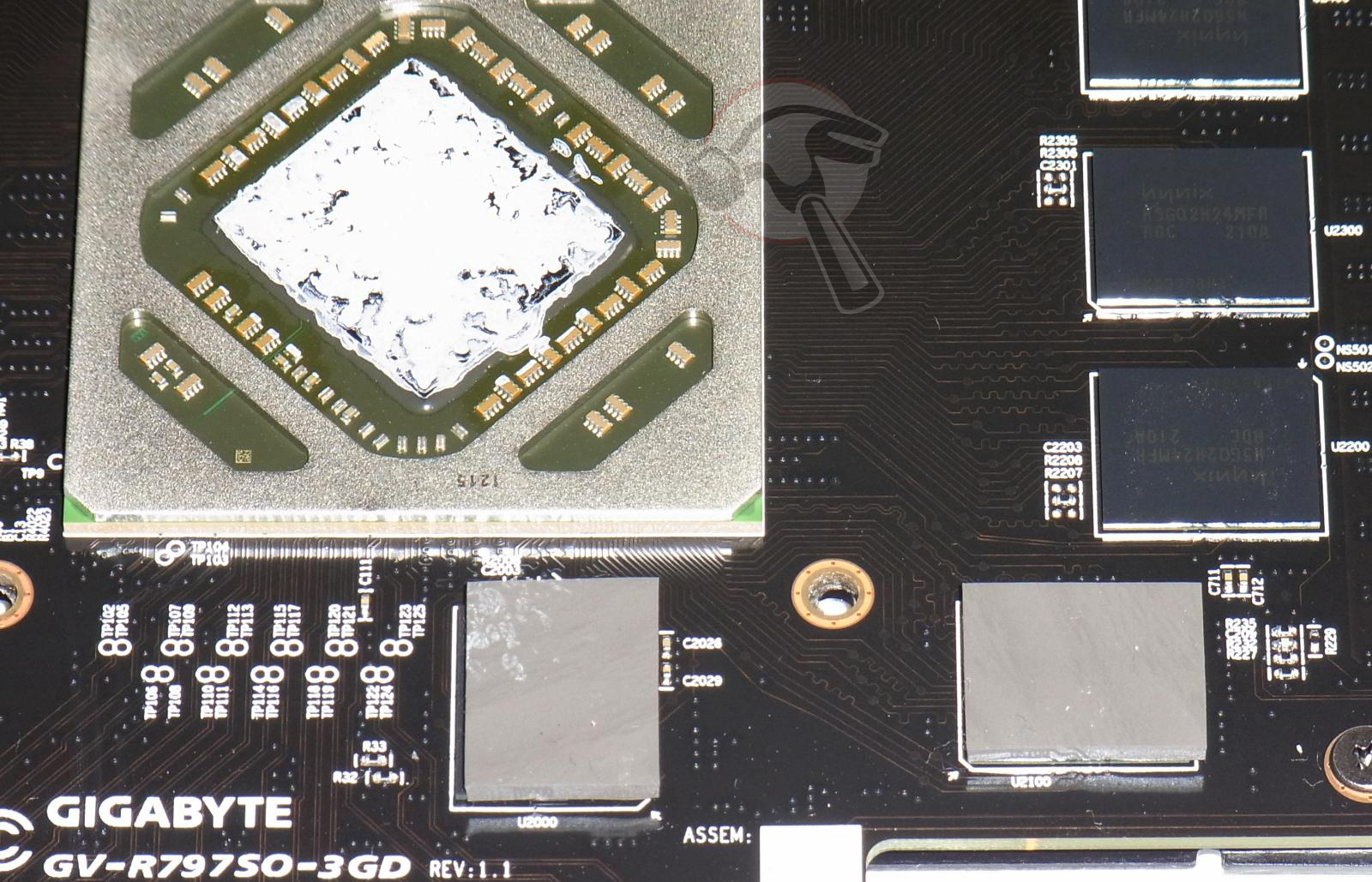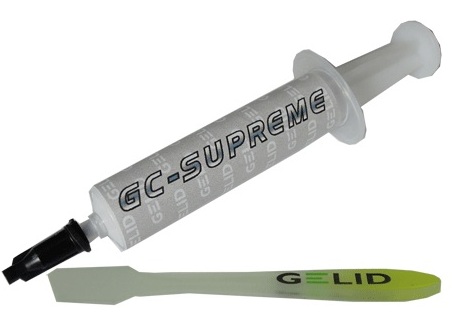Gigabyte Radeon HD 7970 Super Overclock: Now With Windforce 5X
Gigabyte’s Radeon HD 7970 Super Overclock is huge, heavy, overclocked, and very different-looking. Its Windforce 5X cooler employs five 40 mm fans. We benchmark the card, spend some time tweaking it, and measure the noise those blowers make.
Modifying Gigabyte's Windforce 5X Cooler
The Vapor Chamber: Just A Tad Too Small
Even though the Radeon HD 7970 Super Overclock's vapor chamber is huge, it’s not quite large enough. It’s easy to see that it was originally designed for Gigabyte's GeForce GTX 680, and would have needed about 1 cm more to properly fit the 7970.
Just look at the large yellow rectangle in the picture below. You can see that the two memory packages at the bottom aren’t completely covered. But because the vapor chamber doesn't touch the RAM at all (even the ICs that are covered), Gigabyte uses thermal pads on them. This turns out to be counterproductive, since the pads isolate the memory from circulating air.
Not surprisingly, we saw graphics glitches when we overclocked the card’s RAM. They went away after we scraped off the thermal pads using a box cutter. Even if you don't go to that extreme, you should be alright, so long as you keep the memory running below 1500 MHz.
The heat sink does a better job of cooling the card's voltage transformers and coils, which have their own aluminum plate dedicated to drawing thermal energy away.
Thermal Paste: Room for Improvement
The Radeon HD 7970 Super Overclock's thermal paste proved to be thick in both consistency and application. After an initial round of (disappointing) temperature benchmarks, and after talking to Gigabyte, we decided to replace its compound with our own and repeat the benchmarks.
Get Tom's Hardware's best news and in-depth reviews, straight to your inbox.
We settled on Gelid Supreme as our thermal paste of choice due to its easy application and short time to reach maximum transfer performance. We also found that four of the six screws holding the cooler’s frame either hadn’t been screwed in tightly or came loose in shipping.
It was important to us that the thermal paste stayed elastic, even after being exposed to high temperatures, so that it could handle any possible board flexing. Prolimatech’s thermal compounds have worked well for us in the past, but they need a longer burn-in time to reach their peak performance. We put the card through a four-hour stress test before running our benchmarks.
The following tests weren't conducted with Gigabyte's thermal paste, but with our substitution. We believe that the card would have shown similar results to our own had it not encountered transport problems and suffered incorrect application of its original thermal compound.
Current page: Modifying Gigabyte's Windforce 5X Cooler
Prev Page Gigabyte's Cooling Solution, Up Close Next Page In Video: Noise And Fan Speed Results
Igor Wallossek wrote a wide variety of hardware articles for Tom's Hardware, with a strong focus on technical analysis and in-depth reviews. His contributions have spanned a broad spectrum of PC components, including GPUs, CPUs, workstations, and PC builds. His insightful articles provide readers with detailed knowledge to make informed decisions in the ever-evolving tech landscape
-
unksol While the cooler is an interesting concept, and the cards components are solid build quality and attention to detail seem to be severely lacking. The cooler isn't even designed for this board. Loose screws? thermal pads and TIM you have to scrape off/replace and void your warranty? And on a review sample of all things. I can't imagine one off the line would improve that situation...Reply
And while good on Toms for reporting it why isnt the card tested as it comes from the factory so we know what to actually expect... -
I will surely like to have that Gigabyte HD 7970 Super Overclock graphics card and be the only one in the US to claim so.Reply
-
amuffin The Gigabyte SOC Cards were always on of the most intriguing series out there of GPU's!Reply -
jase240 I like the idea of this card, but really that thing is LOUD. I have an Asus GTX 670 Direct CUII TOP and its silent even at load its barely audible. Personally I think if someone is going to overclock to the extent that they need a card that keeps the ambient temps to be low, they will probably be liquid cooling their CPU with a radiator at the top of their case(that's what I'm doing).Reply
Honestly though if this card could be a little quieter it would be a great standard considering most people do still overclock with air coolers, and one thing bad for air coolers is a hot GPU blowing air towards the CPU. -
goodguy713 To be honest i think its a pretty sexy card.. loud yea.. but still a sweet card.. ill keep my fingers crossed..Reply -
gsxrme Water cooling is truly the only option for really overclocking. Those fans are way to noisy. I wish toms had a 1300Mhz GTX680 listed because my factory ASUS reference board even hits 1300Mhz Core / 6750Mhz Ram with no mods or voltage tweaks. I don't see this as a breakthrough and with the cost of 2500 res monitors less than 1% of the market are running that high.Reply -
nforce4max This card isn't meant for the chickens that want cards to mostly silent but is for those who are much more aggressive in overclocking while being more forgiving when it comes to noise. This card isn't that loud compared to some rack mounted servers, I think that you guys could have pushed it further (why not) despite the power consumption. I like the build quality despite the R10 rated inductors that are driving the memory and gpu Q_Q As for the cooler I wonder if the heat pips only make contact with the vapor chamber or actually part of it? It isn't hard to design a good cooler but will cost more to produce.Reply
A lot of noise is a lot cheaper than going liquid cooling and as hot as it gets where I live you Need a really good cooling solution.


